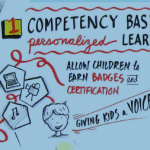Building a Bridge Between Blended Learning and Competency Education
CompetencyWorks Blog
A big light went on during a conversation with Anthony Kim of Education Elements:
WHAT IF… The process used by districts that already use blended learning to transition to competency education is different from the process used by districts with little ed-tech that start with competency-based in their journey to personalization?
Blended-first districts that have infused their curriculum, instruction and assessment with all that technology can do, are turning to competency education as a natural progression from the self-paced nature of adaptive software and online learning. There are specific aspects that competency education can provide – empowering students to own their education through transparent expectations, ensuring students can apply academic skills, focusing attention on habits or lifelong learning competencies, and strengthening college and career readiness by building the capacity among teachers to assess competencies/skills. And most importantly, creating the structure to support students — students that are not yet proficient, students that are performing at academic levels 2+ years behind their grade levels and students ready to leap forward in their studies. Districts converting to competency education usually start with an equity agenda that every student should be proficient (often described as doing what is right for kids) and that the traditional system is in the way. The questions that drive them are, How can we empower students to own their education?; How do we know if students are successfully learning and what are we going to do when they aren’t?; and How do we provide enough flexibility that each and every student is making progress at a reasonable pace? The questions aren’t particularly different than the ones that districts that embrace blended learning ask — it’s just that one turned to structure and one to technology as the first steps forward.
An example of blend-first districts approaching competency education somewhat differently is seen in the report from Digital Promise’s League of Innovative Schools’ spring meeting. The League listed competency-based learning as the first challenge that superintendents are encountering as they move forward in their reforms. The list of problems related to competency education is what you might expect: grades/assessment; teacher prep programs; student data management and analytics; state and federal policy; and culture and language. The solutions (shared definition, policy, models) indicated that we definitely need to build a bridge between the worlds of blended and competency education, as meeting participants either don’t know about or have difficulties with the definitions for competency education that have developed already, such as the one developed by the field that CompetencyWorks uses and Great Schools Partnership’s definition.
Their Ideas for Action suggested that the blend-first districts might bring a different sensibility to our work, proposing that the technical solution to track competencies and credits might be done through micro-credentials/badges. How interesting: Imagine asking your 10-year-old neighbor, “What badges are you working on?” instead of, “What grade are you in?” Badges might be a great way to keep the solid infrastructure of standards but do away with the bureaucratese and linearity that comes along with it.
The big challenge for all of us is in expanding our knowledge and/or expanding our network of collaborative colleagues who can help us create personalized schools that are both blended and competency-based. (I keep trying to figure out a really cool acronym for this but have failed so far – any ideas?) Susan Patrick and I have been putting together a list of the expertise that is needed to implement both blended and competency-based for a meeting of technical assistance providers – and it’s humbling. In order for us to accelerate the process of conversion to fully personalized districts, we are going to have to integrate these two sets of expertise into a common language and simultaneous change processes.